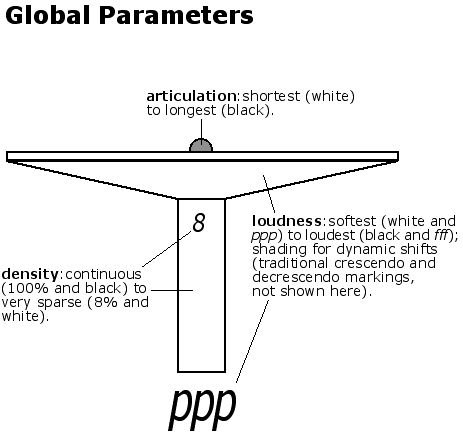The Concept
 In
2002, I was asked to contribute a series of workshops
at the Museum of Glass in Tacoma, WA, as part of its grand opening which would tie into
the work of John Cage, one of three visual artists contributing work to the
Museum's inaugural exhibition. Greatly influenced
by Cage on many levels, I proposed a translation of the I
Ching into sound using graphic notation,
an idea uncovered during a middle school residency in Tacoma,
Washington where I taught students graphics notation methods for
performance by untrained musicians. Here, the art classes had became
the composers for the sound art classes culminating in a performance
for the entire school. The scores been drawn out in the schools visual
art classes and then taught and performed by the sound art
classes. For me, this was a transformaive experience that revealed the
potential for creating complex and repeatable musical structures for untrained musicians and even children.
In
2002, I was asked to contribute a series of workshops
at the Museum of Glass in Tacoma, WA, as part of its grand opening which would tie into
the work of John Cage, one of three visual artists contributing work to the
Museum's inaugural exhibition. Greatly influenced
by Cage on many levels, I proposed a translation of the I
Ching into sound using graphic notation,
an idea uncovered during a middle school residency in Tacoma,
Washington where I taught students graphics notation methods for
performance by untrained musicians. Here, the art classes had became
the composers for the sound art classes culminating in a performance
for the entire school. The scores been drawn out in the schools visual
art classes and then taught and performed by the sound art
classes. For me, this was a transformaive experience that revealed the
potential for creating complex and repeatable musical structures for untrained musicians and even children.
While too abstract for my 7th graders, it was a simple logical next step, for the Glass Museum workshop, to translating hexagrams into sound textures, where one could then seek judgments from the I Ching for sounds textures rather than for decisions about everday life. Where a question could be formed like "What sounds, or Lycons, would be useful in this space and time?" Therefore, using the I Ching rules of divination, a set of hexagrams and associated set of graphic symbols could result. A performer would consult the book, produce one or more hexagrams, or any number of players could do likewise and produce additional hexagrams related to the same query. These would be performed to an agreed upon strategy (the divination process could be included as part of the presentation), to form compositions of meaning and beauty.
 And so I standardized the children's notation and developed a system for translating
the I Ching all in time
to present a workshop at the new Museum of Glass which was attended by Bill Nye, The Science Guy
who immediately took over the show explaining, most articulately, how the
continous turning method worked to my students. Overall it
was a daunting project but the
workshop series were popular beyond expectations.
And so I standardized the children's notation and developed a system for translating
the I Ching all in time
to present a workshop at the new Museum of Glass which was attended by Bill Nye, The Science Guy
who immediately took over the show explaining, most articulately, how the
continous turning method worked to my students. Overall it
was a daunting project but the
workshop series were popular beyond expectations.
Since 2002 I have taught many workshops using this notation with and without using the I Ching. Some of these workshops evolved into the International Space Band performances, some concert performances and still others, a combination of these.
In 2016, I recorded the 64 Lycons derived from the 64 Hexagrams of the I Ching which have been added to this documentation and to produce Lyconbinates I available on CD Baby.
Lycon recordings = performance of 1 Lycon to a level of 4 without interacton.
Lyconbinates recordings = mix of 2 or more of the Lycons recordings.
Site Index
© Dan Senn 2018, BMI